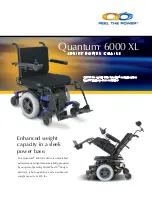
58
Crossing obstacles
The obstacle crossing capability depends
on the driving surface gradients, the ad-
justment of the leg supports and other
factors.
Each crossing of obstacles involves a risk!
– tilting danger of the electric wheelchair.
The crossing of obstacles is a special dan-
ger situation in which a combination of the
safety advice in the sections headed uphill
driving, downhill driving and driving trans-
verse to a slope must be observed in addi-
tion to other safety advice.
Keep well clear of obstacles like ruts, rails
and gully covers or similar sources of dan-
ger.
Always drive slowly and at a right (90°) angle
towards small obstacles, e.g. curbs/edges.
Cross the obstacle forwards with about 0.5
m approach and simultaneously with both
front- resp. rear wheels. Otherwise your
electric wheelchair could tilt diagonally and
you could fall out of the electric wheelchair.
Always maintain a safety distance between
the wheelchair and drops, stairs and similar
obstacles sufficient for reaction, braking and
turning.
If possible, let one or more helpers lift you
out of the electric wheelchair and carry you
to the destination point.
You can easily fall out of the electric wheel-
chair when driving down a step (e.g. pave-
ment curb) if the footplates or leg supports
land on the driving surface []. The crossing
of rails or ruts requires increased attention.
– Unwanted course deviation!
The safe driving on stairs is impossible with
conventional electric vehicles.
Electrical system
An incorrect and/or inappropriate modifi-
cation of the driving behaviour can impair
the safety of the electric wheelchair and
the electric wheelchair user. – Danger of
accidents!
The electronic control system of the elec-
tric wheelchair must not be modified.
Should the electric wheelchair react in an
unaccustomed manner or fulfil uncontrol-
lable manoeuvres, the joystick/director is to
be brought back into the neutral position/
initial position immediately and/or the elec-
tric wheelchair to be switched off at once.
Transport in public methods of
transportation
Your electric wheelchair is not designed for
user transport in public transportation vehi-
cles. Limitations may occur. We recommend
use of one of the firmly built in seats of the
public vehicle.
Should it nevertheless become necessary to
carry out the transport while sitting in the
electric wheelchair, the following needs to
be observed:
–
Use the space designated by the public
transportation services for parking.
–
Observe the regulations of the trans-
port company before parking the elec-
tric wheelchair.
–
Park your electric wheelchair opposite
to the driving direction in the reserved
space.
–
The electric wheelchair is to be placed
so that the back support it will be sup-
ported by the border of the parking
space.
–
One side of the electric wheelchair
must also lie against the border of
the parking space, so that the electric
Summary of Contents for 1.610 MC1
Page 87: ...87 NOTES...
















































